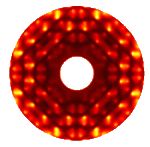Interactive examples: solutions for interference and Bragg's law

Basic examples
Single atom
Pair of atoms
Row of atoms
Interactive examples
1D crystal builder
Polygons of atoms
Different atoms
Ewald sphere
Units
Interference
Bragg's law
Goto
Contents
- Example 1:
Interference by two slits :
Playing with the
parameters generating the interference by two slits should
have shown you:
- As you increase angle under which you observe the interfering waves, the amplitude of the diffracted wave oscillates. Every time that the value of d*sin(alpha)/lambda is an integer number, the amplitude is high. If d*sin(alpha)/lambda is 0.5, 1.5, 2.5 etc. the amplitude is zero.
- As you increase the distance between the slits, the angle at which the amplitude vanishes for the first time becomes smaller.
- As you increase the wave length, the angle at which the amplitude vanishes for the first time becomes larger. If the wave length is larger than d*sin(90)/0.5 = 2*d, the amplitude never vanishes completely.
- The maximum amplitude that you can get is the sum of the two individual amplitudes.
- Example 2: Bragg's law:
- As you increase angle under which you observe the interfering waves, the amplitude of the diffracted wave oscillates. Contrary to the last example, the formula is slightly different. Every time that the value of 2*d*sin(theta)/lambda is an integer number, the amplitude is high. If 2*d*sin(theta)/lambda is 0.5, 1.5, 2.5 etc. the amplitude is zero. Note the additional factor of 2. This relationship is the well known Bragg's law.
- To visuallize the optical retardation, i.e. the length of the extra stretch that the red wave travels, count off the number of wave lengths between the two diagonal black lines. This stretched is drawn as a thicker red line. The two diagonal lines mark the wave front. Before the first and after the second wave front, the relative phase of the two waves does not change.
- As you increase the distance between the slits, the angle at which the amplitude vanishes for the first time becomes smaller.
- As you increase the wave length, the angle at which the amplitude vanishes for the first time becomes larger. If the wave length is larger than 2*d*sin(90)/0.5 = 4*d, the amplitude never vanishes completely. Even for lambda greater than 2*d we would never observe the first oder Bragg reflection. As a consequence, you cannot use very long wave lengths for a diffraction experiment !
- The maximum amplitude that you can get is the sum of the two individual amplitudes.
- The position of the atom on the upper layer does not influence the interference at all! The length of the extra stretch that the red wave travels does not change as you move the atom within the upper plane.